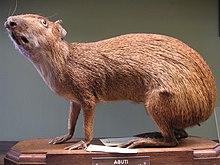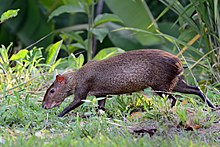Agoutis
| Agoutis | ||||||||||||
|---|---|---|---|---|---|---|---|---|---|---|---|---|

Agouti |
||||||||||||
| Systematics | ||||||||||||
|
||||||||||||
| Scientific name | ||||||||||||
| Dasyprocta | ||||||||||||
| Illiger , 1811 |
The agoutis ( Dasyprocta ) are a genus of rodents . Together with the acouchis (also known as dwarf or tailed agoutis) they form the family of agoutis and acouchis (Dasyproctidae). The genus includes eleven species.
distribution
Agoutis are native to Central and South America, their original range extends from southern Mexico to northern Argentina .
description
Agoutis have slender bodies that rest on thin, long legs. The front legs have four toes, the rear legs, which are significantly longer, end in three toes. All toes have hoof-like claws and are adapted to continuous locomotion. Their fur is thick and rough, it is mostly dark orange or brownish in color. The underside is white or yellowish. The massive head sits on a short neck and has small, round ears and large eyes. The tail is just a stub one to four centimeters long. Agoutis reach a head body length of 42 to 62 centimeters and a weight of 1.5 to 4.0 kilograms.
The guard hairs have a particularly distinctive ring pattern, which gives their name to similar hair patterns (agouti rings).
Way of life
Agoutis inhabit a range of habitats , including forests, dense bushland, and savannahs , but also fields and plantations . They are primarily diurnal , only in heavily populated areas do they come out of their hiding place at dusk. They use self-dug structures as shelter, but also hollow tree trunks and dense vegetation.
Agoutis are ground dwellers whose physique is geared towards running fast. They are toe-walkers (digigrad) and quickly gallop away when threatened. Well-trodden paths from their shelters to their grazing areas make it easy to get on quickly. When eating, they sit on their hind legs and take their food in their front paws, from this position they can escape without losing much time.
Agoutis live solitary or in pairs. They inhabit a fixed territory, which they defend aggressively at least against conspecifics of the same sex. Her forms of communication include raising her back hair - a threatening gesture - and a series of sounds, including an alarm tone reminiscent of a dog barking.
food

Agoutis are herbivores that are not picky about foraging. They consume fruits, nuts, leaves, stems and roots. There are reports of them following groups of primates and eating the fruit that fell on them. When eating, agoutis stand on their hind legs and hold the food between their paws. In the Amazon, agoutis are almost the only animals that the hard capsule fruits with their strong teeth Brazil nut can open. Since they bury the nuts that are not eaten in the manner typical of rodents, they make a decisive contribution to the spread and maintenance of the Brazil nut stocks.
Reproduction
In most regions, mating can occur year round. As part of the mating ritual, it was observed that the male splashes the female with his urine, causing her to dance violently. After repeating this process several times, pairing occurs. The gestation period is around 100 to 120 days, and the litter size is one or two, rarely three. Newborn agoutis are hairy and displaced, they can walk within an hour. After around five months, the young are weaned, and when the female is pregnant again, it separates from the young. The highest known age of an agoutis was almost 18 years.
Agoutis and ecosystem
Agoutis can be important for the spread of plants and carry seeds away ( zoochory ). The Central American agouti is closely related to the spread of guapinol ( Hymenaea courbaril ), so that the range of the tree often coincides with that of the rodent. Although the seed fruits are quite large, the animals transport them up to 200 m. There the seeds have a higher probability of survival than under the mother plant, "where 99% of the seeds fall victim to other rodents or the collar peccary".
Agoutis and people
On the one hand because they often invade plantations and devastate them, on the other hand because of their tasty meat, agoutis are hunted by humans. Before the arrival of the Europeans, agoutis were introduced by Indian peoples to provide food on several Caribbean islands, and these stocks are now considered extinct.
Hazardous situation
The destruction of their habitat contributes next to the persecution by humans that five of the eleven species on the Red List of Threatened Species of the World Conservation Union IUCN stand. As a small (endangered Near Threatened ) is Orinoco agouti evaluated; The Coiba agouti is judged as endangered ( Vulnerable ) ; The Roatán agouti is endangered ( Endangered ) and the Mexican agouti is seen as critically endangered . Another species, the azara agouti , was listed as endangered in 1996; However, insufficient data is currently available for an assessment ( data deficient ).
Systematics
A total of eleven types of agoutis are distinguished. The acouchis or dwarf agutis form their own genus ( Myoprocta ).
- The azara agouti ( Dasyprocta azarae ) lives in southern Brazil and northern Argentina . The IUCN lists it as endangered.
- The Coiba agouti ( D. coibae ) is endemic to the island of Coiba off the coast of Panama . It is considered threatened.
- The crested aguti ( D. cristata ) is common in Guyana , Suriname and French Guiana .
- The black agouti or black agouti ( D. fuliginosa ) lives in northern South America (from Colombia to the Amazon region ).
- The Orinoco agouti ( D. guamara ) lives in the Orinoco Delta in Venezuela .
- The Kalinowski agouti ( D. kalinowskii ) is native to southeastern Peru and has an unclear threat status.
- The gold agouti ( D. leporina , the designation D. aguti is outdated) is native to northern and central South America.
- The Mexican agouti ( D. mexicana / Sereque ) lives in southern Mexico . It is listed as critically endangered.
- The black-bellied aguti ( D. prymnolopha ) occurs in eastern Brazil.
- The Central American agouti ( D. punctata ) is distributed from southern Mexico to Argentina. It is listed as low risk.
- The Roatan agouti ( D. ruatanica ) is on the Bay Islands belonging island Roatan off the coast of Honduras ' endemic. It is considered threatened.
Agoutis form together with the acouchis in the systematics valid here a family Agoutis and Acouchis (Dasyproctidae). In some systematics the pakas ( cuniculus ) are also included, but these should not be too closely related.
literature
- Malcolm C. McKenna, Susan K. Bell: Classification of Mammals. Above the species level. Revised edition. Columbia University Press, New York NY 2000, ISBN 0-231-11013-8 .
- Ronald M. Nowak: Walker's Mammals of the World. 2 volumes. 6th edition. Johns Hopkins University Press, Baltimore MD u. a. 1999, ISBN 0-8018-5789-9 .
- Don E. Wilson , DeeAnn M. Reeder (Eds.): Mammal Species of the World. A taxonomic and geographic Reference. 2 volumes. 3. Edition. Johns Hopkins University Press, Baltimore MD 2005, ISBN 0-8018-8221-4 .
Web links
Individual evidence
- ↑ Heinrich Dathe , Paul Schöps (Ed.): Pelztieratlas. With the collaboration of 11 specialists. VEB Gustav Fischer Verlag, Jena 1986, p. 24.
- ↑ Winnie Hallwachs: agoutis (Dasyprocta punctata): the inheritors of Guapinol (Hymenaea courbaril: Leguminosae). In: Frugivores and seed dispersal , Volume 15 of the series Tasks for vegetation science , Springer Netherlands, 1986, pp. 285-304, doi : 10.1007 / 978-94-009-4812-9_25 .
- ^ Dasyprocta in the IUCN Red List of Threatened Species 2010. Retrieved March 15, 2010.


